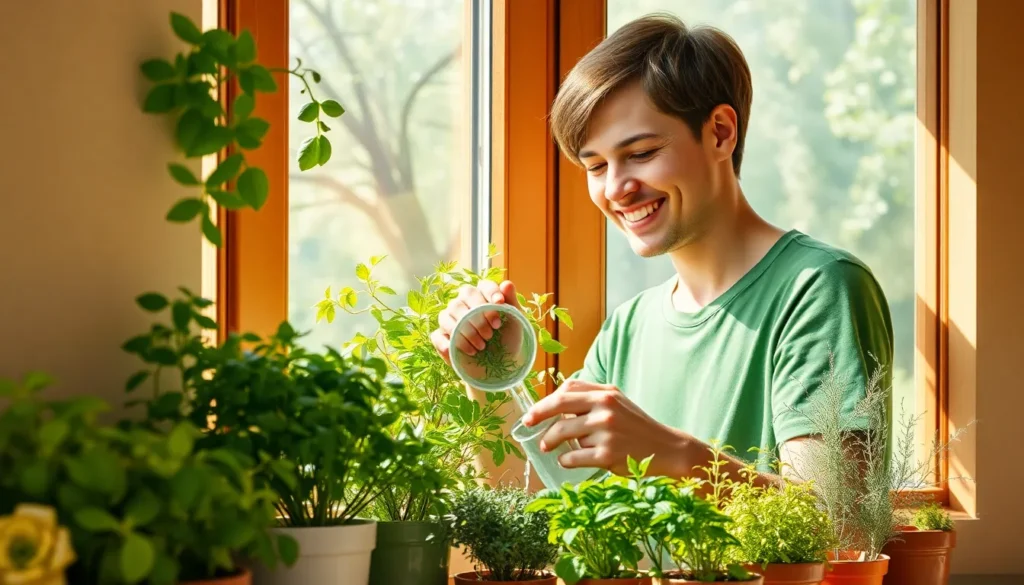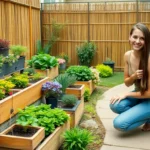Growing fresh herbs at home transforms ordinary meals into culinary masterpieces while saving money on expensive store-bought alternatives. We’ve discovered that creating an herb garden doesn’t require acres of land or expert gardening skills – just the right ideas and a passion for fresh flavors.
Whether you’re working with a sprawling backyard or a tiny apartment balcony, we’ll show you how to design the perfect herb garden that fits your space and lifestyle. From vertical wall gardens that maximize small areas to traditional raised beds that accommodate dozens of varieties, there’s a solution for every home.
The best part? Most herbs are incredibly forgiving and actually thrive with minimal care. We’ve compiled proven herb garden ideas that’ll have you harvesting fresh basil, rosemary, and thyme within weeks, turning your cooking adventures into something truly special.
Container Herb Garden Ideas for Small Spaces
Limited space doesn’t mean you can’t enjoy fresh herbs in your cooking. We’ve discovered creative container answers that maximize herb growing potential in the smallest areas.
Window Box Herb Gardens
Window boxes transform any windowsill into a productive herb garden that brings fresh flavors within arm’s reach. We recommend using boxes that are at least 6 inches deep to accommodate most herb root systems. Cedar or composite materials work best since they resist weather damage and provide excellent insulation for plant roots.
Plant compact herbs like chives, oregano, and thyme in window boxes since they won’t outgrow the limited space. Space plants 4 to 6 inches apart to prevent overcrowding and ensure proper air circulation. Water retention becomes crucial in window box gardens, so we add a layer of mulch to help soil stay moist longer.
Position your window box on south or west facing windows to capture 6 to 8 hanging hours of direct sunlight daily. Most culinary herbs thrive in these bright conditions and will produce more flavorful leaves. Secure boxes with sturdy brackets that can support the weight when soil becomes saturated with water.
Tiered Planter Arrangements
Tiered planters create vertical herb gardens that fit perfectly on patios, balconies, or even countertops. We stack containers of decreasing sizes to form pyramid shapes that house multiple herb varieties in one compact footprint. This arrangement allows us to grow 8 to 12 different herbs in the same space typically needed for 3 to 4 plants.
Design your tiers using galvanized metal, ceramic, or food grade plastic containers with drainage holes in each level. Place taller herbs like rosemary and sage in back tiers, while shorter varieties such as parsley and cilantro occupy front positions. Water flows naturally from upper to lower tiers, creating an efficient irrigation system.
Consider sun requirements when arranging herbs in your tiered system. Mediterranean herbs like lavender and oregano prefer top tier placement where they receive maximum sunlight exposure. Shade tolerant herbs including mint and lemon balm work well in lower tiers where they get filtered light.
Hanging Basket Combinations
Hanging baskets maximize vertical space while creating stunning displays of cascading herbs that serve both culinary and decorative purposes. We select baskets that are 12 to 14 inches in diameter to provide adequate root space for herb combinations. Coconut fiber lined baskets offer excellent drainage while maintaining an attractive natural appearance.
Choose trailing herbs like trailing rosemary, creeping thyme, and golden oregano for dramatic cascading effects. Combine these with upright growing herbs such as basil and chives to create textural contrast in your hanging displays. Plant 3 to 5 herbs per basket depending on their mature sizes and growth habits.
Install sturdy hanging hardware that supports 15 to 20 pounds when baskets are fully watered. We space hanging baskets 18 to 24 inches apart to prevent overcrowding and ensure each basket receives adequate light. Rotate baskets weekly so all sides receive equal sun exposure for balanced growth patterns.
Indoor Herb Garden Ideas for Year-Round Growing
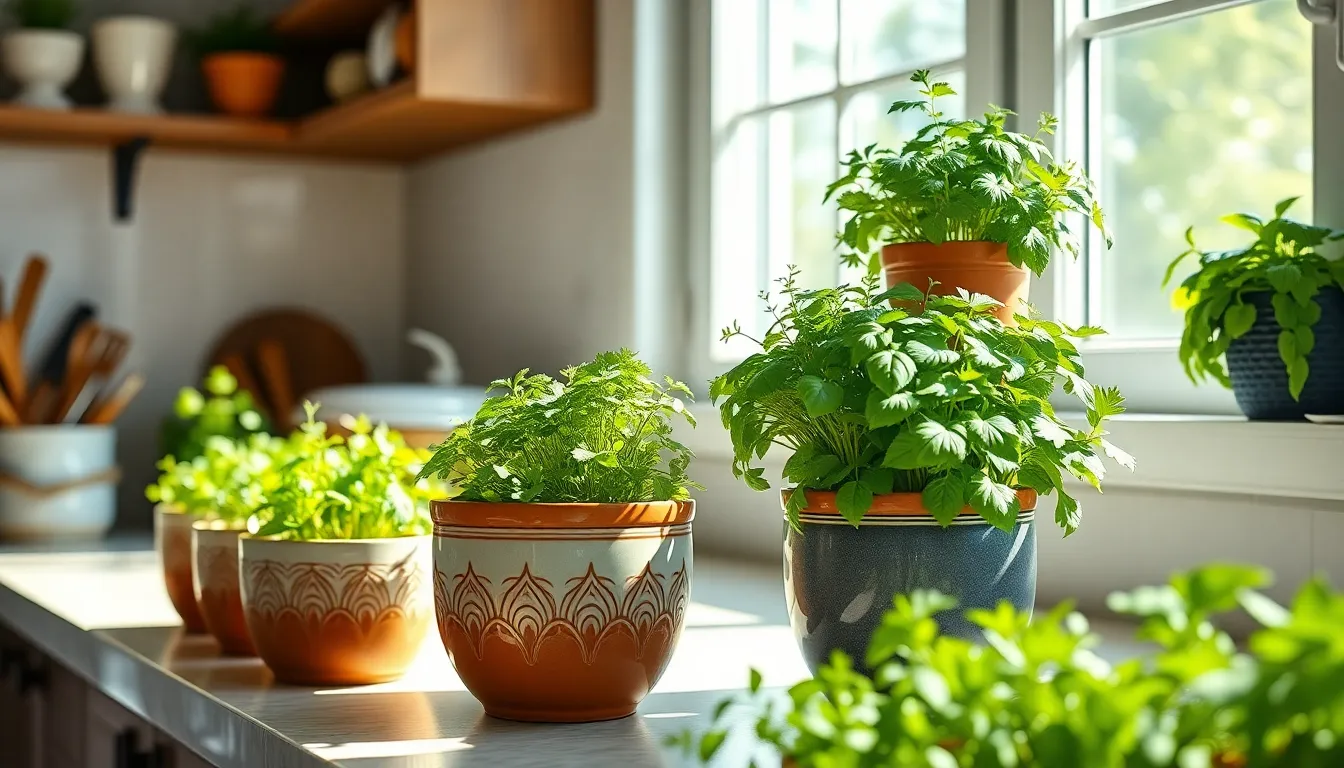
Bringing herbs indoors transforms your home into a fresh herb haven that’s accessible every day of the year. We’ll explore proven methods that ensure your favorite cooking herbs thrive regardless of outdoor weather conditions.
Kitchen Counter Herb Stations
Countertop herb gardens put fresh flavors right at your fingertips while you cook. We recommend starting with compact herbs like basil, cilantro, and parsley since they adapt well to bright kitchen environments and don’t require extensive space.
Maximize your counter space by using tiered planters or decorative pot clusters that create vertical growing arrangements. Choose containers with drainage holes and fill them with well-draining potting mix to prevent root rot issues that commonly affect indoor herbs.
Position your herb station near your cooking area but away from heat sources like stoves or ovens. Basil thrives in warm kitchen conditions while parsley prefers slightly cooler spots away from direct heat.
Windowsill Garden Setups
Natural sunlight from windows provides the ideal growing conditions for most culinary herbs. We’ve found that south-facing windows deliver the most intense light, making them perfect for sun-loving herbs like rosemary and sage.
East and west-facing windows work exceptionally well for parsley, mint, and oregano since these herbs prefer moderate light conditions. Rotate your plants weekly to ensure even growth and prevent them from leaning toward the light source.
Container selection matters for windowsill success. Use wide, shallow containers for spreading herbs like mint and oregano, while deeper pots work better for herbs with taproot systems like parsley and basil.
Watering technique plays a crucial role in windowsill herb health. Monitor soil moisture regularly and use bottom watering methods to promote strong root development while avoiding overwatering issues.
Hydroponic Herb Systems
Soilless growing systems offer faster herb production with less maintenance than traditional container gardening. Popular hydroponic herbs include basil, mint, cilantro, and parsley, which adapt quickly to nutrient-rich water environments.
Simple countertop kits provide an excellent starting point for hydroponic beginners. These systems typically include built-in LED lighting and automated watering cycles that eliminate guesswork from herb cultivation.
Advanced automated systems feature programmable timers and nutrient monitoring that optimize growing conditions throughout the day. We’ve observed that these setups often produce herbs 25-50% faster than soil-grown alternatives.
Water and nutrient management requires regular monitoring to maintain optimal growing conditions. Check water levels weekly and adjust nutrient concentrations according to your system’s specifications to ensure healthy herb development.
Raised Bed Herb Garden Ideas for Organized Growing

Raised beds transform herb gardening by providing better organization and easier maintenance than traditional ground-level plots. We’ll explore design strategies that maximize both productivity and visual appeal while keeping your herbs within easy reach.
Geometric Pattern Designs
Checkerboard layouts create striking visual contrast while organizing different herb varieties into distinct squares. We recommend alternating aromatic herbs like lavender with culinary varieties such as oregano to create both functional and beautiful patterns.
Concentric circles work exceptionally well in square or rectangular raised beds measuring 39½” L x 16½” W. Place taller herbs like rosemary in the center circle and surround them with shorter varieties in outer rings for optimal sun exposure.
Modular grid systems allow us to customize planting sections based on each herb’s exact needs. Create separate compartments for moisture-loving herbs versus drought-tolerant varieties, making maintenance more efficient and targeted.
L-shaped configurations maximize corner spaces while serving as attractive borders around vegetable plots. These designs work particularly well when positioned to receive at least six hours of direct sunlight daily.
Companion Planting Layouts
Border plantings with lavender and oregano attract beneficial pollinators while naturally deterring harmful pests from nearby vegetables. We’ve found these aromatic herbs create protective barriers that enhance the entire garden network.
Integrated vegetable pairings boost both flavor and plant health when we combine exact herbs with compatible crops. Planting basil alongside tomatoes in raised beds enhances tomato flavor while discouraging aphids and hornworms.
Window box integrations near kitchen doors provide immediate access to fresh herbs while supporting companion planting strategies. Position these compact gardens to complement larger raised bed layouts for seamless herb harvesting.
Pollinator-friendly clusters combine flowering herbs like bee balm and chamomile with culinary varieties to support local bee populations. These thoughtful arrangements improve overall garden productivity through enhanced pollination.
Seasonal Rotation Plans
Spring and summer rotations focus on heat-loving herbs including basil, cilantro, and dill that thrive in warm weather conditions. We plant these varieties after the last frost date to ensure optimal growth and continuous harvests.
Cool season transitions shift emphasis to hardy perennials like rosemary, thyme, and sage during fall and winter months. These robust herbs maintain productivity even in cooler temperatures while improving soil structure.
Quick-growing interplanting maintains soil vitality by rotating herbs with fast-maturing vegetables or edible flowers between growing seasons. This practice prevents nutrient depletion while maximizing raised bed productivity year-round.
Soil health preservation requires strategic crop rotation to prevent pest buildup and maintain consistent soil moisture. We’ve discovered that alternating herb families every season significantly reduces disease pressure and extends garden longevity.
Vertical Herb Garden Ideas to Maximize Space
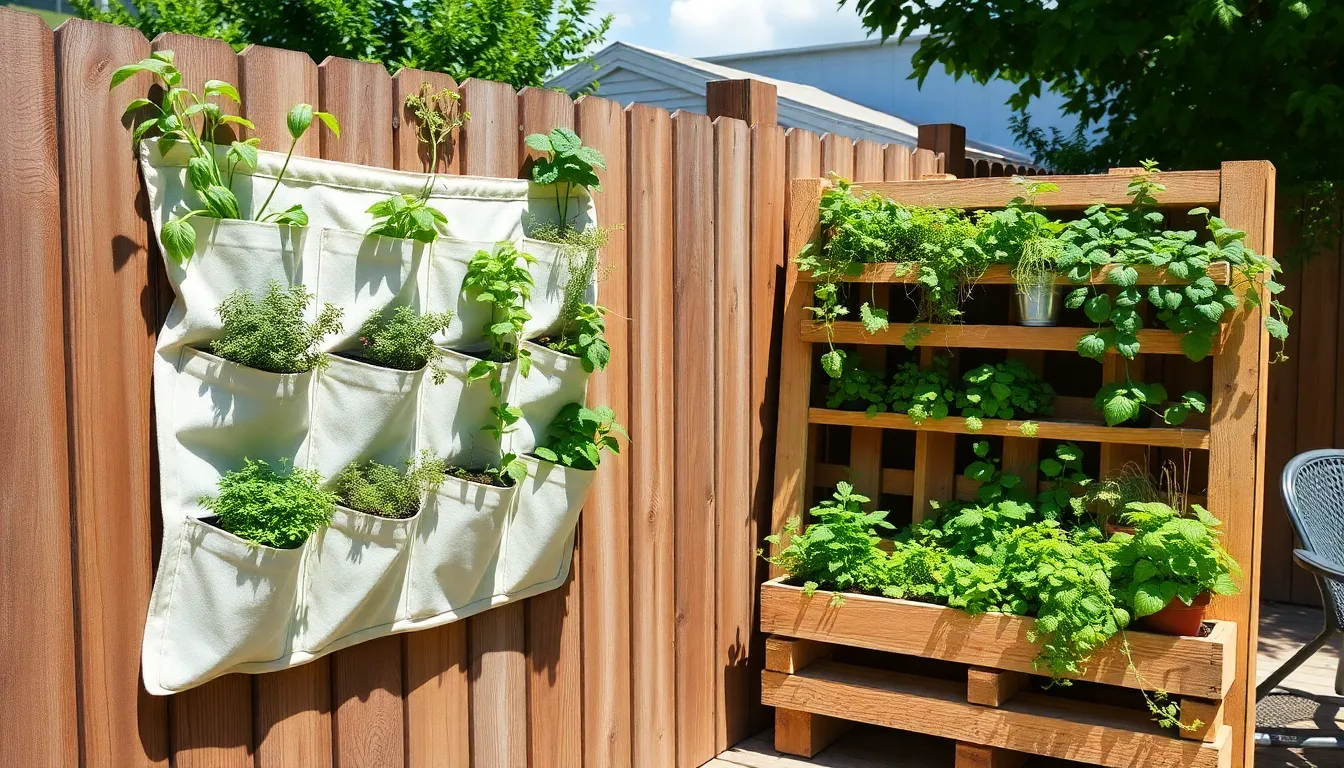
When we’re working with limited space, growing herbs vertically transforms any wall or fence into a productive garden. These space-saving answers let us cultivate fresh herbs without sacrificing valuable floor space.
Wall-Mounted Pocket Gardens
Wall-mounted pocket gardens maximize vertical space by using fabric or modular pocket systems that attach directly to any wall surface. We can create these living walls using DIY fabric pocket gardens or commercial modular vertical planters that hold multiple herb varieties in compact pockets. These systems work exceptionally well for compact herbs like basil, thyme, and salad greens that don’t require deep root systems.
Installing these pocket gardens is straightforward and they’re perfect for small spaces like patios, balconies, or even indoor walls. The beauty of this approach lies in how it transforms unused wall space into a lush green wall of fresh herbs. We can easily access different herbs at eye level, making harvesting and maintenance much more convenient than traditional ground-level gardens.
Trellis and Ladder Displays
Trellis and ladder displays provide essential structure for vertical herb growth, particularly benefiting vining plants like peas and beans that naturally climb upward. We can train these climbing herbs to grow vertically, dramatically saving ground space while creating an attractive vertical garden feature.
Ladder planters offer multiple tiers that allow us to stack small pots of different herbs, effectively using vertical space in a compact footprint. A popular DIY approach involves creating multi-tiered ladder planters that accommodate many herb varieties while maintaining easy access to each plant. This method enhances garden aesthetics while providing practical growing space for gardeners who want multiple herbs within arm’s reach.
Repurposed Pallet Gardens
Repurposing wooden pallets into vertical herb gardens offers an eco-friendly and cost-effective solution for maximizing growing space. We can transform standard pallets by adding shelves, pockets, or planting boxes to create vertical planting surfaces ideal for herbs, flowers, and small vegetables.
These pallet gardens are incredibly versatile and portable, allowing us to hang them on walls or lean them against fences depending on our space requirements. The sustainability aspect makes this approach particularly attractive since we’re recycling materials that might otherwise go to waste. Pallet gardens work well for herbs that don’t require deep soil, and they can be easily moved to follow sunlight patterns throughout the day.
Themed Herb Garden Ideas for Culinary Enthusiasts
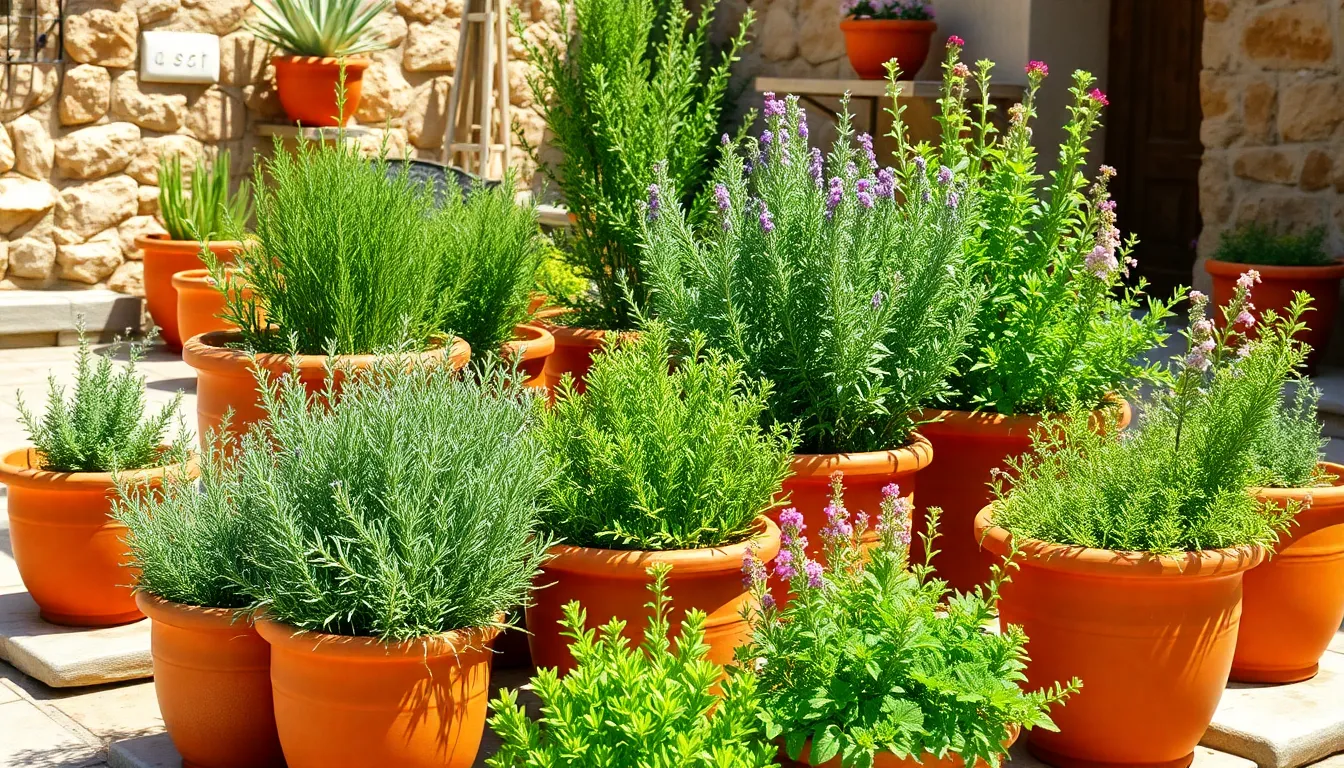
Creating specialized herb gardens around exact cuisines transforms your cooking experience while adding visual interest to your outdoor space. We’ll explore three distinct approaches that organize herbs by their culinary traditions and uses.
Mediterranean Herb Collections
Mediterranean herb gardens capture the essence of coastal European cooking with drought-tolerant plants that thrive in well-drained conditions. Rosemary stands as the cornerstone herb, providing woody stems that release aromatic oils when heated. Thyme varieties like common thyme and lemon thyme add earthy complexity to roasted vegetables and grilled meats. Oregano delivers the pungent flavor essential for pizza sauces and Greek dishes.
Bay laurel trees offer fresh leaves that surpass dried versions in intensity and aroma. We recommend planting these herbs in raised beds filled with sandy soil that mimics Mediterranean growing conditions. Position your collection in the sunniest part of your garden since these herbs originated in regions with intense sunlight and minimal rainfall.
Design your Mediterranean plot using terra cotta containers or stone borders that reflect the rustic aesthetic of the region. Group taller herbs like rosemary toward the back while placing low-growing thyme varieties as natural ground cover in front.
Asian Cuisine Herb Gardens
Asian herb gardens require different growing strategies since many essential herbs prefer moist conditions and controlled environments. Cilantro thrives in cooler weather and should be succession planted every few weeks for continuous harvests. Mint varieties including spearmint and chocolate mint need containers to prevent aggressive spreading throughout your garden space.
Lemongrass requires warm temperatures and ample water, making it perfect for container growing in most climates. Thai basil differs significantly from Italian varieties with its anise-like flavor and purple-tinged leaves. We suggest dedicating separate containers for each herb since their water and spacing requirements vary considerably.
Create an Asian herb station near your kitchen using tiered planters that accommodate different root depths. Place moisture-loving herbs like cilantro in deeper containers while shallow-rooted varieties like Thai basil work well in standard pots. Position this collection where it receives morning sun but afternoon shade to prevent delicate leaves from scorching.
Tea and Medicinal Herb Plots
Tea and medicinal herb gardens combine wellness benefits with aromatic pleasure through carefully selected plant varieties. Chamomile produces delicate flowers that create soothing bedtime teas when dried properly. Mint species including peppermint and spearmint support digestive health while providing refreshing tea options year-round.
Lemongrass contributes citrusy notes to herbal blends and offers natural antibacterial properties. Echinacea flowers support immune system function and add purple blooms that attract beneficial pollinators to your garden space. We recommend researching each herb’s medicinal properties before consumption and consulting healthcare providers when using herbs therapeutically.
Separate your tea herbs from medicinal varieties using distinct garden beds or container arrangements. Harvest tea herbs in the morning after dew evaporates but before afternoon heat concentrates essential oils. Create a dedicated drying area near your herb plot using mesh screens or hanging bundles to preserve maximum potency in your homemade teas.
Creative Herb Garden Ideas Using Recycled Materials
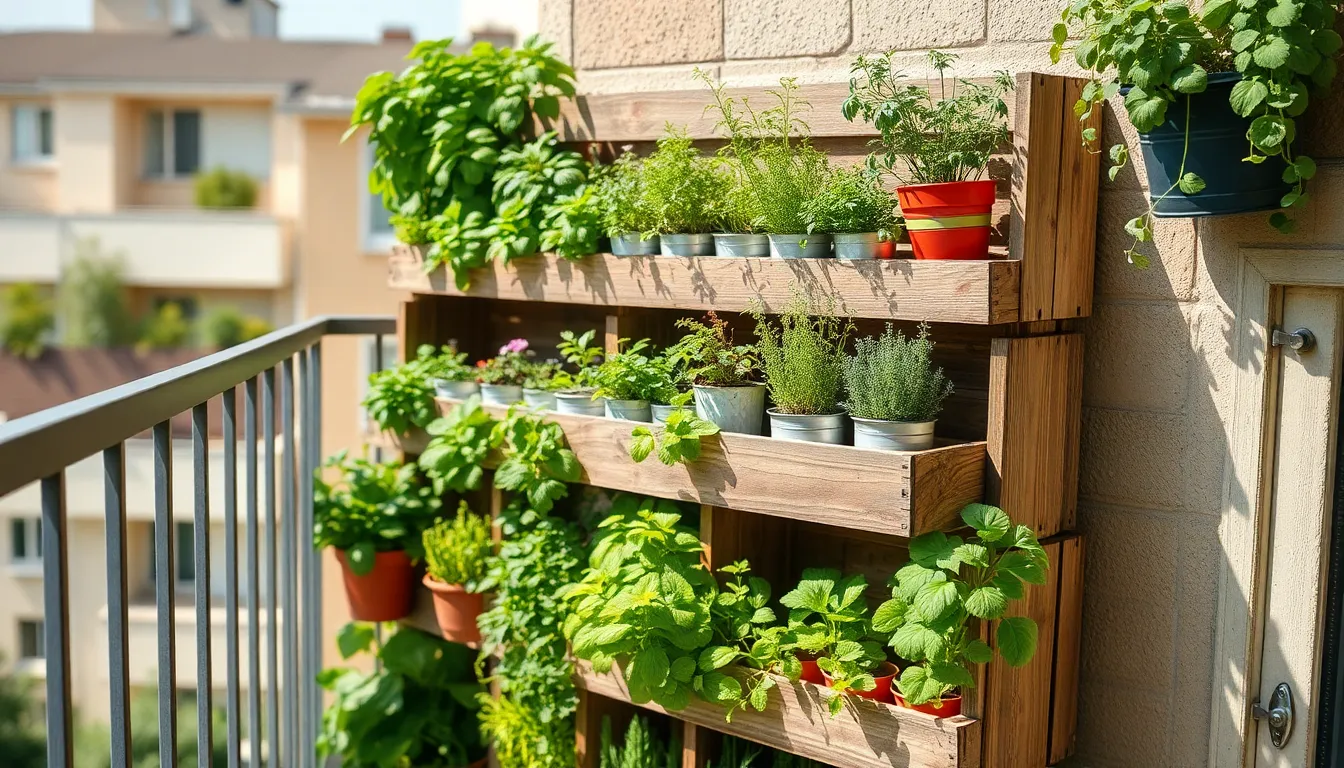
Reducing environmental impact while growing fresh herbs becomes achievable through creative recycling projects. We’ll transform everyday discarded items into functional herb gardens that save money and showcase our eco-friendly gardening approach.
Upcycled Container Gardens
Plastic bottles offer our most versatile recycled container option for herb cultivation. We can clean and cut milk jugs, water bottles, and soda containers to create vertical hanging gardens perfect for small spaces like apartment balconies. These lightweight containers mount easily on wooden supports and work exceptionally well for compact herbs like oregano and thyme.
Tin cans from our kitchen pantry transform into charming rustic planters with minimal effort. We clean vegetable and soup cans thoroughly, then decorate them with paint or twine to match our garden aesthetic. These containers suit both indoor windowsill displays and outdoor herb collections, providing excellent drainage when we puncture small holes in the bottom.
Household containers expand our recycling possibilities beyond traditional options. We repurpose paper cups for seed starting, eggshells with cartons for biodegradable mini pots, and plastic cookie containers for larger herb plants. Toilet paper rolls work particularly well since we can plant them directly in soil where they decompose naturally.
Repurposed Furniture Planters
Old drawers create unique multi-compartment herb planters that organize different varieties efficiently. We line wooden drawers with industry fabric, add drainage holes, and fill them with quality potting soil for herbs like basil, cilantro, and parsley. These repurposed pieces add vintage charm while maximizing our growing space.
Wooden crates and pallets serve as excellent vertical herb walls when mounted upright. We can arrange multiple crates in stair-step formations or convert single pallets into pocket planters by adding fabric backing. These structures work particularly well for Mediterranean herbs that prefer good air circulation.
Shelving units offer tiered growing opportunities when we convert them into herb display gardens. We place containers on different levels to accommodate varying light requirements, positioning sun-loving herbs like rosemary on upper shelves and shade-tolerant varieties like mint below.
DIY Garden Structures
Recycled wood frames support our container gardens while creating organized growing systems. We build simple rectangular frames from wooden blinds or railing pieces to hang bottle gardens or support can planters. These structures allow us to customize size and shape according to our available space.
Mini greenhouse structures extend our growing season using large plastic bottles as individual plant covers. We cut off bottle bottoms and place them over young herb plants, creating warm humid environments ideal for sensitive varieties like basil during cooler weather. This technique helps us maintain herb production year-round.
Support systems maximize vertical space through creative engineering with recycled materials. We construct ladder-style displays from old wooden slats or build hanging systems using sturdy rope and reclaimed metal brackets. These DIY structures accommodate multiple container sizes while keeping our herb garden organized and accessible.
Perennial Herb Garden Ideas for Low Maintenance
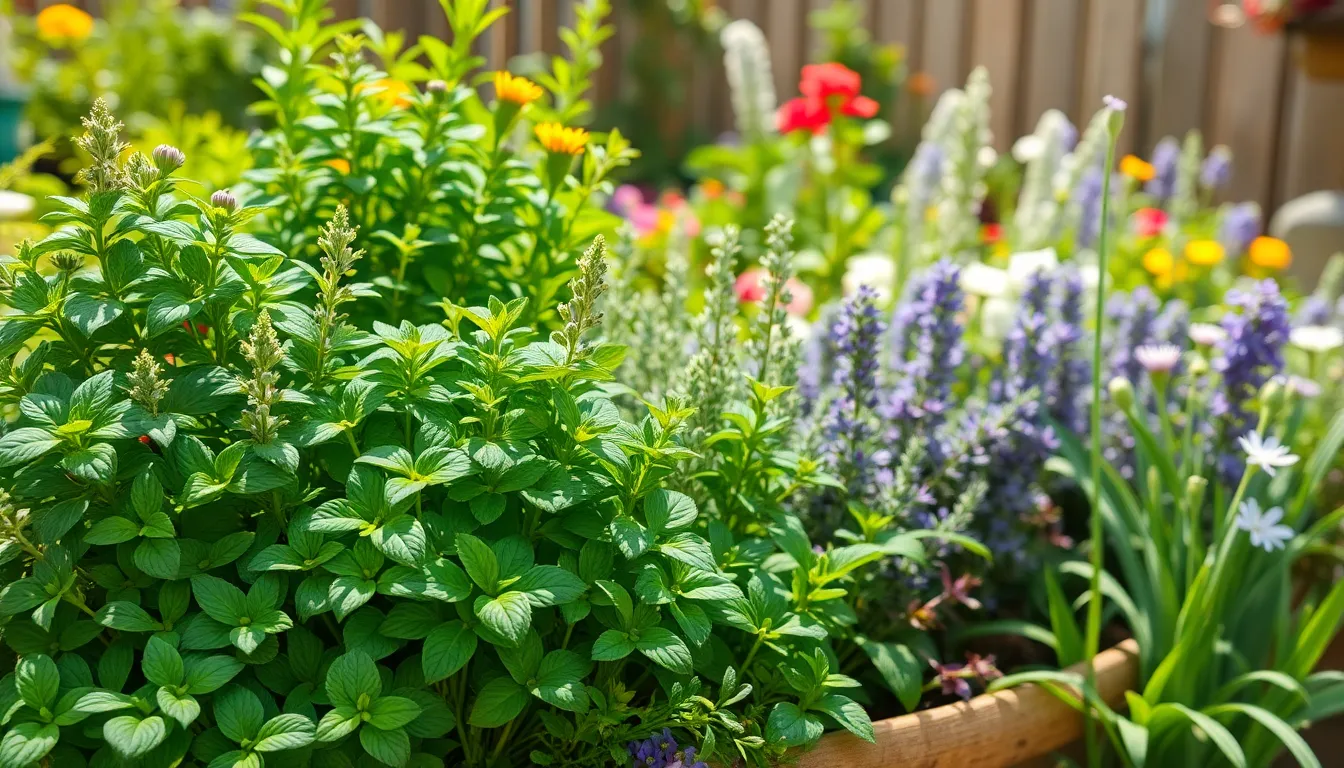
Perennial herbs offer the perfect solution for gardeners who want continuous harvests without replanting each year. We’ll explore the best low maintenance options that’ll thrive with minimal care while providing fresh flavors for your kitchen.
Hardy Herb Selections
Mint stands out as one of the most robust perennial herbs you can grow. This versatile plant thrives in part shade and moist, well drained soil, making it adaptable to various garden conditions. We recommend containing mint in pots or designated areas since it spreads aggressively.
Oregano delivers exceptional drought tolerance while flourishing in sunny locations. Once established, this Mediterranean herb requires minimal watering and produces fragrant leaves throughout the growing season. Plant oregano in well drained soil for best results.
Thyme proves incredibly hardy and drought resistant, perfect for full sun areas with poor soil conditions. This low growing herb creates beautiful ground cover while providing culinary value. We love how thyme handles neglect better than most garden plants.
Sage thrives in dry environments with excellent drainage requirements. This silvery leafed herb tolerates harsh conditions while producing aromatic foliage for cooking. Position sage in areas that receive full sun for optimal growth.
Chives prefer full sun and average soil conditions, making them ideal starter herbs for beginners. These onion flavored perennials return year after year with purple blooms that attract beneficial insects.
Self-Seeding Varieties
Chives naturally reproduce through self seeding, creating new plants without your intervention. We’ve observed how these hardy perennials drop seeds that germinate in spring, expanding your herb collection effortlessly.
Mint spreads through its extensive root system, effectively colonizing new garden areas. This aggressive growth habit means you’ll have plenty of mint plants developing from the parent plant’s underground runners. Control mint’s spread by growing it in containers or installing root barriers.
Drought-Tolerant Options
Oregano handles extended dry periods once established in well drained soil. We recommend this herb for xerophytic gardens where water conservation is important. Plant oregano in raised beds or slopes where drainage naturally occurs.
Thyme excels in drought conditions, requiring minimal supplemental watering after establishment. This Mediterranean native actually develops stronger flavors when grown in drier conditions. We suggest grouping thyme with other drought tolerant herbs like rosemary and sage.
Sage demonstrates remarkable drought tolerance in well drained locations. This herb develops deep root systems that access moisture unavailable to shallow rooted plants. Position sage on south facing slopes or raised areas for optimal drainage.
Rosemary survives with less water once established, though it needs more attention than other drought tolerant herbs. We recommend deep, infrequent watering rather than frequent shallow irrigation. Plant rosemary in well drained soil to prevent root rot during wet periods.
Beginner-Friendly Herb Garden Ideas for New Gardeners
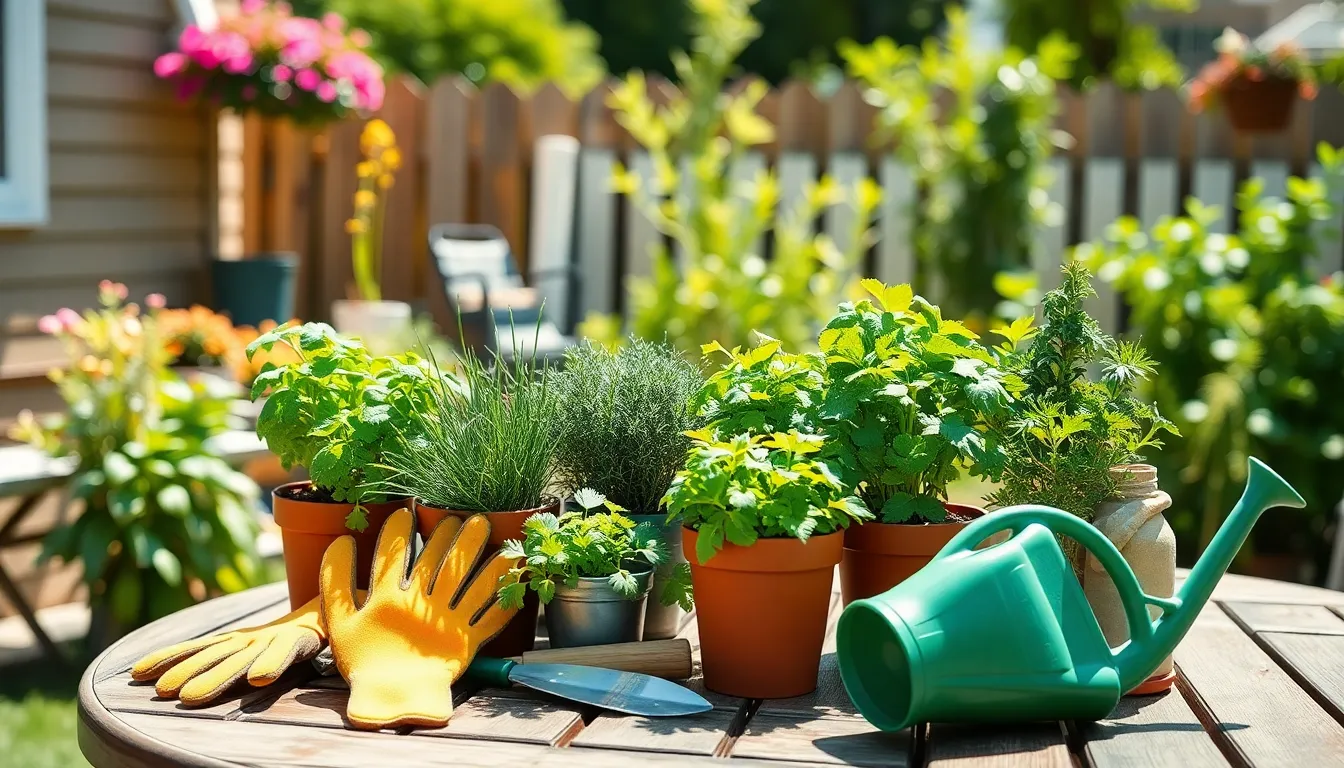
Starting your herb garden journey doesn’t require years of experience or perfect conditions. We’ve compiled essential strategies to help you create a thriving herb garden that delivers fresh flavors to your kitchen with minimal effort.
Easy-to-Grow Starter Herbs
Basil tops our list as the perfect beginner herb because it grows easily from seed or seedlings and adapts well to various growing conditions. Most gardeners find success with this aromatic plant in both containers and garden beds.
Chives require minimal maintenance and thrive in small spaces, making them ideal for apartment dwellers or those with limited garden areas. These onion-flavored herbs tolerate neglect better than most other varieties.
Cilantro grows directly from seed when planted in sunny locations and provides quick results for new gardeners eager to see progress. Fresh cilantro leaves appear within weeks of planting.
Mint offers versatility in cooking and medicinal uses, though we recommend containing it in pots to prevent invasive spreading throughout your garden. Different mint varieties like spearmint and peppermint provide unique flavor profiles.
Parsley serves as a reliable biennial herb that’s simple to cultivate and provides fresh leaves for two growing seasons. Both flat-leaf and curly varieties grow well for beginners.
Simple Layout Designs
Container gardening works perfectly for balconies, patios, or small outdoor spaces using individual pots or larger planters. We suggest starting with 6-8 inch containers for single herbs or larger planters for multiple varieties.
Raised beds provide better drainage and allow you to control soil conditions while mimicking herbs’ natural growing environments. These elevated gardens also reduce back strain during planting and harvesting.
Vertical gardens maximize space by growing herbs upward along walls, fences, or specially designed structures. Wall-mounted pocket gardens or tiered systems work exceptionally well for small areas.
Basic Care Requirements
Lighting needs vary among herbs, but most varieties require full sun to partial shade conditions for optimal growth. We recommend observing your space throughout the day to determine sun exposure patterns.
Watering should maintain moist but well-drained soil to prevent root rot, which commonly affects overwatered herbs. Check soil moisture by inserting your finger one inch deep before watering.
Soil quality improves dramatically when using well-balanced potting mix designed for container growing or amended garden soil. Quality soil provides essential nutrients for healthy herb development.
Fertilization benefits most herbs when applied monthly using balanced fertilizer during the growing season. Organic options like compost tea or fish emulsion work particularly well for edible herbs.
Regular harvesting encourages healthy growth and prevents plants from becoming overgrown or going to seed prematurely. Plant tags help you understand exact light and water requirements for each herb variety in your garden.
Herb Garden Ideas for Companion Planting
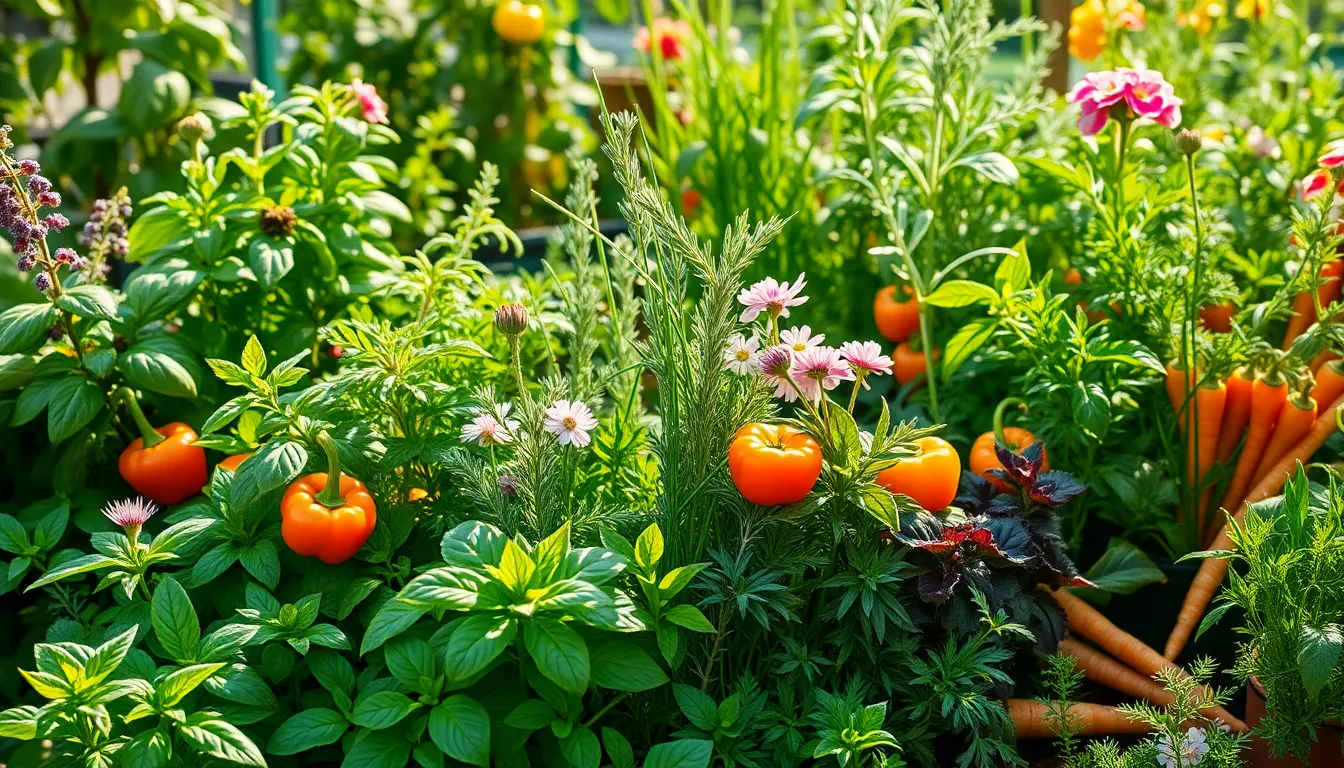
Companion planting transforms your herb garden into a thriving network where plants support each other naturally. Strategic herb placement creates beneficial partnerships that enhance growth, deter pests, and improve soil quality.
Pest-Repelling Herb Combinations
Basil serves as nature’s mosquito and fly deterrent while simultaneously protecting nearby vegetables like peppers, eggplant, and squash from harmful insects. Planting basil strategically around outdoor seating areas provides natural pest control for both plants and people.
Thyme and rosemary create powerful barriers against cabbage moths when positioned near brassicas like broccoli, brussels sprouts, cauliflower, and kohlrabi. These Mediterranean herbs release aromatic compounds that confuse and repel destructive moths.
Chives offer dual protection benefits by discouraging carrot rust fly when planted alongside carrots and warding off aphids when positioned near roses. Growing chives in borders around vulnerable crops creates natural pest-free zones.
Mint repels ants and aphids effectively but requires container planting to prevent invasive spreading throughout your garden. Placing mint containers strategically around affected areas provides targeted pest control without compromising garden organization.
Growth-Improving Plant Pairs
Rosemary encourages basil to flourish through shared environmental preferences and compatible root systems that don’t compete for nutrients. These Mediterranean companions thrive in sunny, warm conditions with well-draining soil.
Sage promotes oregano and savory growth by creating favorable microclimates and releasing beneficial compounds into the surrounding soil. Grouping these perennial herbs together simplifies care requirements while maximizing productivity.
Parsley and cilantro support each other when planted in close proximity, sharing similar moisture needs and soil preferences. These popular culinary herbs create lush, productive patches that provide continuous harvests.
Dill enhances cabbage family crops by improving flavor profiles and supporting healthy growth patterns. Interplanting dill with brassicas creates mutually beneficial relationships that boost overall garden performance.
Soil-Improving Partnerships
Comfrey and yarrow accumulate deep soil nutrients and make them available to shallow-rooted herbs through their extensive root systems. Chopping these nutrient-dense herbs as mulch enriches surrounding soil naturally.
Legume companions like beans fix nitrogen in the soil, providing essential nutrients for neighboring herbs without requiring synthetic fertilizers. Growing beans alongside heavy-feeding herbs creates sustainable nutrition cycles.
Mediterranean herb groupings improve soil structure when rosemary, thyme, lavender, sage, and hyssop share alkaline, nutrient-poor conditions. These drought-tolerant partnerships reduce water needs while building healthy soil communities.
Ever-changing accumulator herbs concentrate minerals from deep soil layers and redistribute them through their leaves and stems. Incorporating these herbs into compost or using them as green mulch creates nutrient-rich growing mediums for companion plants.
Seasonal Herb Garden Ideas Throughout the Year
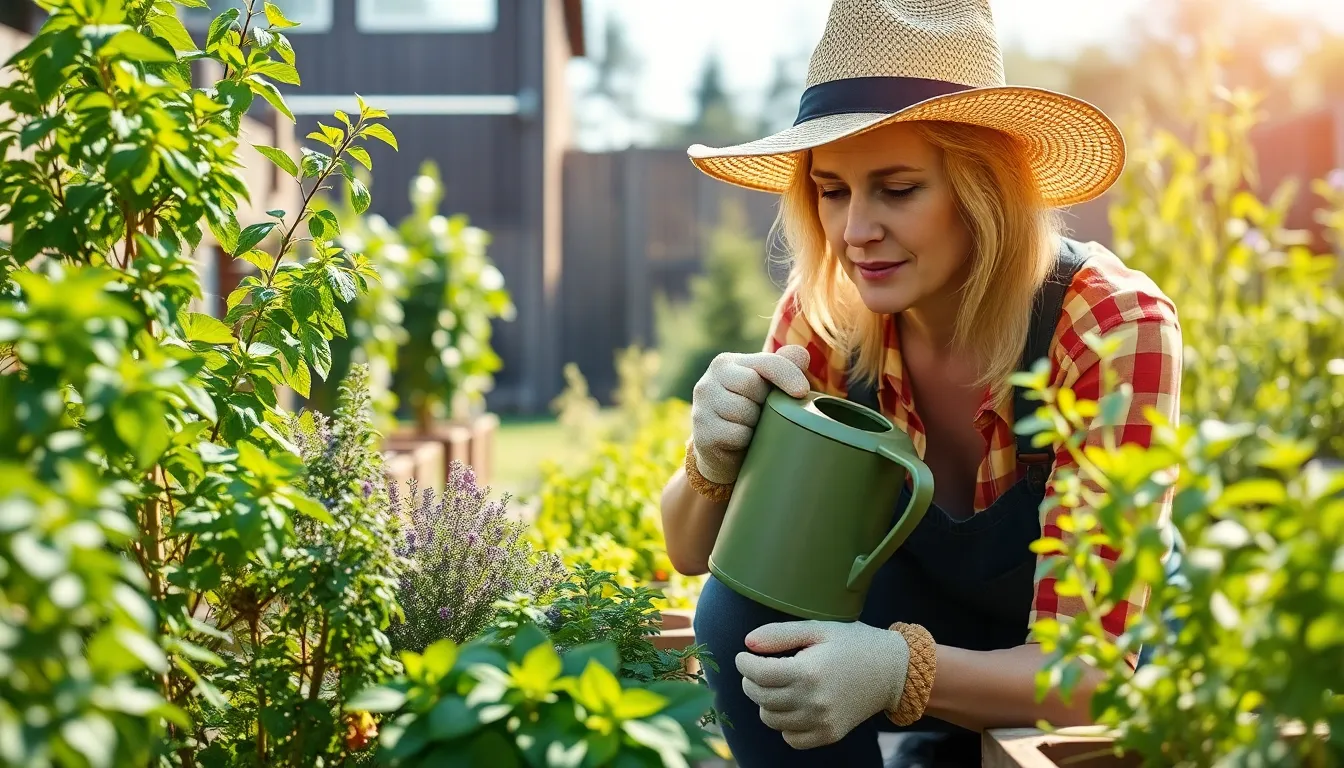
Planning your herb garden around the seasons maximizes harvest yields and ensures healthy plant growth. We’ve organized the most effective seasonal strategies to help you maintain a thriving herb garden year round.
Spring Planting Strategies
Wait until mid-April after the last frost to plant your spring herb garden for optimal success. Popular spring herbs like basil, thyme, mint, cilantro, and dill thrive when planted during this window, giving them the perfect growing conditions they need.
Position your herbs in locations that receive at least six hours of sunlight daily, as this ensures robust growth and concentrated flavors. Well-draining soil prevents root rot while regular watering keeps your herbs hydrated without becoming waterlogged.
Start with container planting if you’re uncertain about soil conditions or want more control over your herbs’ environment. Spring temperatures are ideal for establishing root systems before the intense summer heat arrives.
Summer Harvest Techniques
Prune your herbs regularly throughout summer to encourage new growth and prevent premature flowering, which can make leaves bitter and tough. Regular pruning keeps plants bushy and productive for continuous harvesting.
Use layering techniques to propagate herbs like rosemary, sage, mint, oregano, and thyme during the warm summer months. This method creates new plants while the parent plant continues producing, expanding your herb collection naturally.
Harvest frequently to promote bushier growth patterns and maintain peak flavor concentrations in your herbs. Summer’s warm temperatures accelerate growth, making regular harvesting essential for preventing plants from becoming woody or bitter.
Fall and Winter Preparations
Harvest end of season herbs like sage, lavender, and rosemary before the first frost to preserve them for winter teas and cooking. Drying these herbs extends their usability throughout the colder months when fresh growth slows dramatically.
Protect tender herbs using cloches or by bringing less hardy varieties indoors before temperatures drop below their tolerance levels. This preparation ensures your herb collection survives winter conditions.
Plan for next year’s garden by inventorying existing seeds, ordering new varieties, and preparing indoor spaces for starting early spring crops. Winter planning sets the foundation for an even more successful herb garden in the coming year.
Conclusion
Growing your own herb garden transforms everyday cooking into a flavorful adventure while providing many benefits for your health and wallet. We’ve explored options that work for every living situation – from tiny apartments with windowsill gardens to spacious yards with elaborate raised beds.
The beauty of herb gardening lies in its flexibility and accessibility. Whether you’re drawn to Mediterranean classics or prefer experimenting with Asian cuisine herbs you’ll find approaches that match your interests and skill level. Container gardens recycled materials and companion planting strategies make it easy to start small and expand as your confidence grows.
Remember that successful herb gardening doesn’t require perfection – it’s about enjoying the process and harvesting fresh flavors right from your home. Start with a few easy-to-grow varieties and watch as your garden becomes an essential part of your culinary journey.
Frequently Asked Questions
What are the benefits of growing herbs at home?
Growing herbs at home enhances meal flavors, saves money on grocery bills, and provides fresh ingredients year-round. It’s accessible to everyone regardless of space or gardening experience. Home-grown herbs are more flavorful than store-bought alternatives and eliminate packaging waste, making it an environmentally friendly choice.
What herbs are easiest for beginners to grow?
Basil, chives, cilantro, mint, and parsley are the best starter herbs for beginners. These varieties are forgiving, grow quickly, and require minimal care. They adapt well to different growing conditions and provide frequent harvests, making them perfect for new gardeners to build confidence.
How can I grow herbs in small spaces?
Use vertical gardens, window boxes, hanging baskets, or tiered planters to maximize small spaces. Container gardening works well for apartments, while wall-mounted pocket gardens transform unused wall space. Choose compact herb varieties and utilize windowsills for optimal sun exposure in limited areas.
What’s the difference between annual and perennial herbs?
Annual herbs like basil and cilantro complete their life cycle in one season and need replanting yearly. Perennial herbs such as rosemary, thyme, and oregano return each year, making them low-maintenance options. Perennials often become more established and productive over time.
How often should I water my herb garden?
Most herbs prefer slightly dry conditions between waterings. Check soil moisture by inserting your finger 1-2 inches deep. Water when the top inch feels dry, typically every 2-3 days for containers and less frequently for ground-planted herbs. Avoid overwatering, which causes root rot.
Can I grow herbs indoors year-round?
Yes, many herbs thrive indoors with proper lighting and care. Kitchen counter herb stations work well for basil, cilantro, and parsley. Windowsill gardens provide natural sunlight, while hydroponic systems offer low-maintenance alternatives. Ensure adequate light and proper drainage for indoor success.
What companion plants work well with herbs?
Basil pairs well with peppers and tomatoes, while thyme complements brassicas like cabbage. Rosemary and basil enhance each other’s growth, and parsley works well with cilantro. These combinations can deter pests, improve flavors, and maximize garden productivity through strategic plant partnerships.
How do I harvest herbs properly?
Harvest herbs in the morning after dew evaporates but before heat peaks. Cut stems just above leaf pairs to encourage new growth. Regular harvesting promotes bushier plants and prevents flowering, which can make leaves bitter. Use clean, sharp scissors or pruning shears.
What containers work best for herb gardening?
Choose containers at least 6-8 inches deep with drainage holes. Weather-resistant materials like ceramic, plastic, or wood work well. Ensure containers match herb size requirements – larger herbs like rosemary need bigger pots. Good drainage prevents root rot and promotes healthy growth.
When is the best time to plant herbs?
Spring (mid-April) is ideal for most herbs when frost danger passes. Plant heat-loving herbs like basil after soil warms. Cool-season herbs like cilantro can be planted earlier. Summer allows for continuous planting of quick-growing varieties, while fall focuses on harvesting and preparation.

